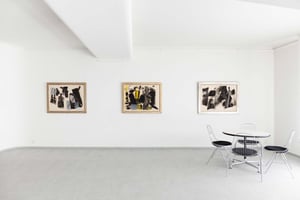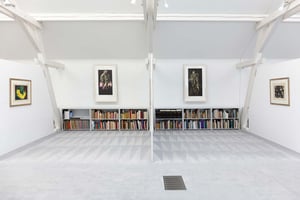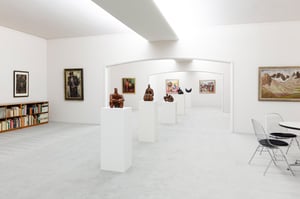GALERIE HENZE & KETTERER | BERN - Bern
- An exhibition to mark the 70th anniversary of documenta and the 120th birthday of Fritz WinterBeschrijving
Fritz Winter. Paths to the documenta (1949-1955)
⇾ 27 feb 2026

- With the Baselitz woodcut "Shepherd (Remix)", 2008Beschrijving
Kirchner and Baselitz. Remix: Repetition in the woodcut
⇾ 19 dec 2025

- Landscapes by Bargheer, Felixmüller, Heckel, Kirchner, Pechstein and Purrmann. Still lifes by Hofer, Kirchner, Nolde, Peiffer Watenphul, Purrmann and Schmidt-Rottluff. People by Eble, Hartung, Kirchner and Rohlfs. Explanations of the individual works of art and artists in this exhibition: In 1938, immediately before his involuntary emigration to Ischia, the Hamburg Secessionist Eduard Bargheer painted his grandiose North Sea mudflat landscape, drawing the flat horizon almost to the upper edge of the picture in an Expressionist manner and sketching a fierce landscape of mudflats at low tide, furrowed by tidal inlets in intense shades of blue and violet. With a scholarship from the Basler Kunstverein, Theo Eble came to the Academy of Arts in Berlin in 1922 and was a master student of Karl Hofer there until 1925, in whose studio this scene of a standing and seated model was probably seen. Theo Eble does not paint them naked and in a pose, but in their normal clothes in a seemingly unobserved moment. Conrad Felixmüller, a painter of the second generation of Expressionists who trained at the Dresden Art Academy, lived from 1918 to 1925 in nearby Klotzsche, practically a suburb, at Gartenstrasse 10. Here is probably a view from the window of this house, when ice and snow turned blue under an overcast sky and rising winter temperatures, and an evening sun from the right brought a few red spots under the clouds onto houses and paths. In 1910, Erich Heckel and Ernst Ludwig Kirchner traveled to Hamburg and visited Gustav Schiefler, the spiritus rector of the early "Brücke" circle of collectors there, and in the following years often visited his country house in Mellingstedt, where Heckel depicted various Alster landscapes and the Mellingburger Schleuse in all techniques. As is so often the case in Erich Heckel's landscapes, the lower half of "Alsterlandschaft (Die Alster bei der Mellingburger Schleuse)" is taken up by a river, in this case the narrow Alster, which widens into a small pond. The opposite shoreline divides the composition horizontally in the middle. On the right, the Alster disappears a little higher under the trees that dominate the upper half of the picture, leaving only a little of the blue sky above free. Although the blue reflected on the surface of the water also dominates the lower half, the composition is overwhelmed by the green of the trees, a spring green. The park landscape becomes a picture of vegetation. The pure landscape was already of great importance in Erich Heckel's early work. It became dominant in the following decades until the 1950s. In it, he was able to develop his pure painting without being distracted by specific and defining objects or people. Here in the fiercely expressive brushstrokes of 1913.Beschrijving
Expressive! Expressionist paintings of the first and second generation
⇾ 19 dec 2025

- Large formats have always played an important role in art history. Be it the pyramids, statues of gods or murals in ancient Egypt, the statues of emperors and generals in ancient Rome or the "cathedrals reaching into the sky" in the Gothic era. For many centuries, the large format had the function of reflecting power, fame and wealth, or to show the social status of a person. Church and pope or even the wealthy, bourgeois client decorated their palaces with opulent frescoes, statues and portraits that wanted to be seen. The large format is still sure to attract attention today. Nevertheless, the function of the large format has shifted in the present. Today, artists increasingly choose it as a means of expressing their artistic freedom. They are no longer primarily bound to a commission (client) or a motif, nor to a particular image carrier. The very own style of each artist comes to bear, as will also be discovered in our exhibition.Beschrijving
XXL Large format works of Modern and Contemporary Art
⇾ 19 dec 2025
